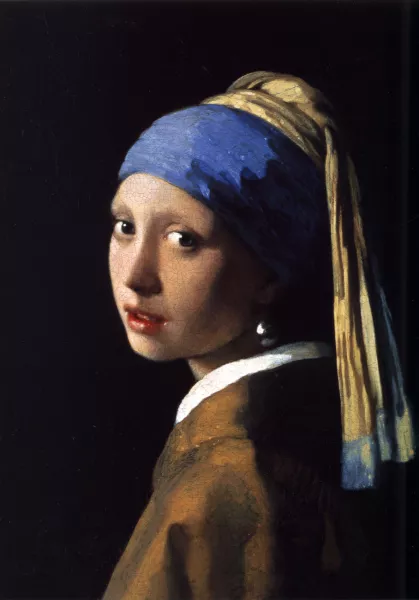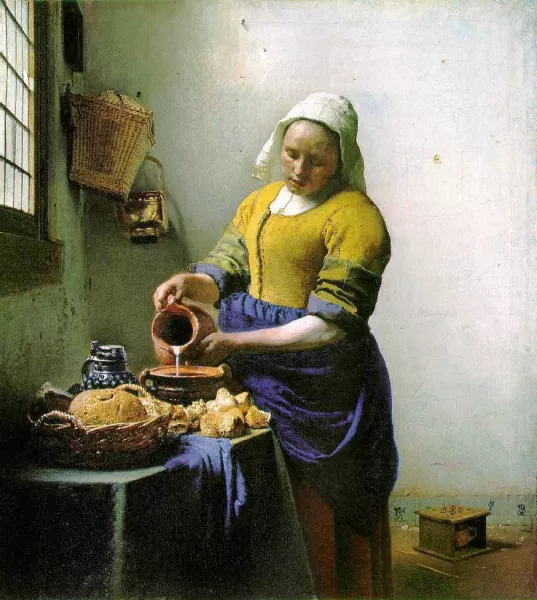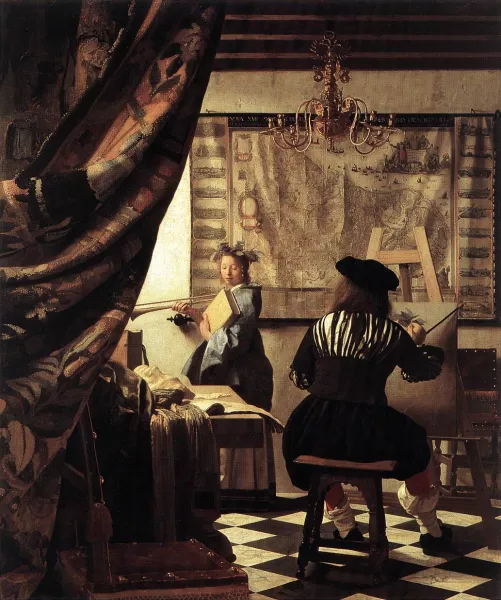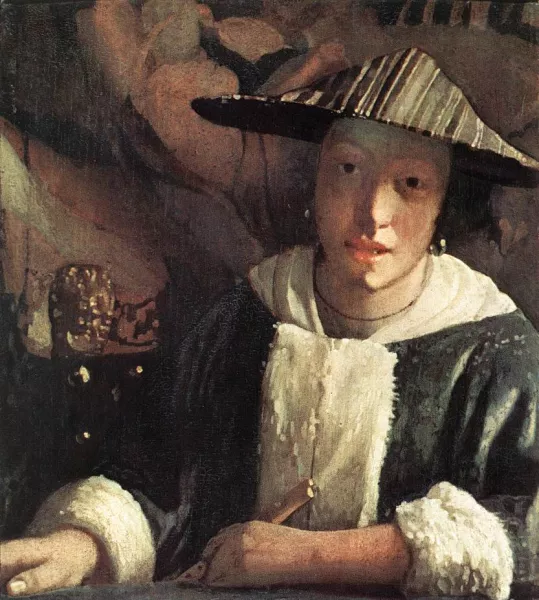- Breadcrumbs
- Blog
- Art Collections
- The Mystery of Vermeer
The Mystery of Vermeer

In the rich tapestry of art history, few figures capture the imagination quite like Johannes Vermeer. This Dutch Golden Age painter, known for his luminous interior scenes and exquisite attention to detail, has left an indelible mark on the world of art. Yet for all his enduring popularity, Vermeer remains a figure shrouded in mystery. His life and career are marked by enigmatic gaps and unanswered questions, fueling centuries of speculation and intrigue among art historians and enthusiasts alike.
Born in Delft in 1632, Vermeer emerged as a singular talent in a time and place celebrated for its artistic achievements. The Dutch Golden Age was a period of unparalleled prosperity and cultural flourishing in the Netherlands, and Delft was a thriving center of art and commerce. It was against this backdrop that Vermeer began his career as a painter, creating works of extraordinary beauty and technical mastery that would secure his place in the pantheon of great artists.
Yet even as Vermeer's reputation has grown over the centuries, the man himself remains an elusive figure. He left behind a remarkably small body of work, with only around 35 paintings definitively attributed to him. This limited output, combined with the scarcity of historical records and documentation about his life, has given rise to countless theories and debates about Vermeer's methods, motivations, and creative process.
At the heart of the mystery surrounding Vermeer is the question of how he achieved such unparalleled mastery in his art. His paintings are characterized by a luminous quality of light, an almost ethereal stillness, and an astonishing attention to detail. From the intricate folds of a satin dress to the delicate play of light across a porcelain dish, Vermeer's works are a testament to his exceptional skill and vision. Yet the techniques he used to achieve these effects remain largely unknown, adding to the aura of mystery that surrounds him.
In this article, we will embark on a journey to unravel the enigma of Johannes Vermeer. We will explore his life and career, delving into the historical context that shaped his artistic vision. We will examine the distinctive style and techniques that set Vermeer apart from his contemporaries, and investigate the theories and debates that have arisen around his limited output and unusual methods. Through a close analysis of his most famous works, we will seek to understand the enduring legacy of this Dutch master and the ways in which his art continues to captivate and inspire us to this day. In the end, we may not solve all the mysteries surrounding Vermeer, but we will come away with a deeper appreciation for the man, his art, and the enduring power of his genius.
Vermeer's Life and Career
Johannes Vermeer was born in 1632 in the city of Delft, located in the Dutch Republic (now the Netherlands). Although little is known about his early life and artistic training, it is believed that he may have studied under the local painter Leonaert Bramer or Carel Fabritius, who was a student of Rembrandt. Vermeer's father, Reynier Jansz, was a silk weaver and art dealer, which likely exposed the young Vermeer to various works of art and may have influenced his decision to pursue a career as a painter.
Vermeer's rise to recognition during his lifetime was slow and modest. He was admitted to the Delft Guild of Saint Luke in 1653, which allowed him to practice as a professional artist and take on apprentices. However, he never achieved widespread fame or financial success during his lifetime. Vermeer's output was remarkably small compared to many of his contemporaries, with only around 35 paintings definitively attributed to him. This limited body of work has led to much speculation among scholars about the reasons behind his low productivity, with theories ranging from his slow, meticulous painting process to his possible involvement in other occupations or family responsibilities.
The Distinctive Style of Vermeer
Vermeer's mastery of light and color is one of the most striking aspects of his distinctive style. He had an exceptional ability to capture the way light falls on various surfaces, creating a sense of depth and realism in his paintings. Vermeer often used a limited palette of colors, including yellow, ochre, brown, gray, and ultramarine blue, to create harmonious compositions. He was particularly fond of using ultramarine, a rare and expensive pigment made from lapis lazuli, which he often used as an undercoat to enhance the visual quality of his paintings.
Vermeer's meticulous attention to detail is another hallmark of his style. He took great care in rendering the textures of different materials, from the soft folds of fabric to the hard, reflective surfaces of metal and glass. This attention to detail, combined with his masterful use of light and shadow, creates a sense of tangible reality in his paintings. Vermeer's works often depict quiet, contemplative moments, with figures lost in thought or engaged in simple, everyday activities. This serene and introspective mood is a key element of his style, inviting the viewer to pause and reflect on the inner lives of his subjects.
Recent research suggests that Vermeer may have used a camera obscura, an early optical device, to aid in his compositions. The camera obscura projects an image of the outside world onto a flat surface, which Vermeer could have used to study the effects of light and perspective. Some of the characteristics of Vermeer's paintings, such as the blurred edges, flattened space, and sharp contrasts of light and shadow, are consistent with the effects produced by a camera obscura. While Vermeer did not simply copy images from the device, he likely used it as a tool to observe and understand the behavior of light, which he then translated into his paintings with remarkable skill and subtlety.
The Mystery of Vermeer's Limited Output
One of the most puzzling aspects of Johannes Vermeer's career is the small number of paintings attributed to him. With only around 35 known works, Vermeer's output is remarkably limited compared to many of his contemporaries. This scarcity has led to much speculation and debate among art historians about the reasons behind his low productivity.
Several theories have been proposed to explain Vermeer's limited output. One possibility is that Vermeer's slow, meticulous working process simply did not allow for a large body of work. His paintings are known for their exquisite detail and technical mastery, which likely required a great deal of time and effort to achieve. Another theory suggests that Vermeer may have been involved in other professions or responsibilities that limited his time for painting. As the father of 11 children, he may have had significant family obligations that took him away from his art. Some scholars have also speculated about potential health issues or an early death that could have cut his career short.
The scarcity of historical records and documentation about Vermeer's life has only added to the mystery surrounding his limited output. Very little is known about his early life, artistic training, or personal circumstances. He left behind no letters, diaries, or other personal writings that might shed light on his creative process or the challenges he faced as an artist. The few existing records, such as his membership in the Guild of Saint Luke and his marriage to Catharina Bolnes, provide only a glimpse into his life and do not fully explain the reasons behind his small body of work.
Despite the many unknowns, Vermeer's limited output has only added to his allure and mystique as an artist. His paintings are highly prized for their rarity and exceptional quality, and they continue to captivate viewers with their luminous beauty and enigmatic charm. The mystery surrounding Vermeer's career has also fueled ongoing research and debate among art historians, who continue to search for new clues and insights into the life and work of this elusive master.
Vermeer's Unusual Painting Techniques
Johannes Vermeer was known for his innovative and meticulous painting techniques, which contributed to the creation of his masterful works. One of the most notable aspects of his technique was the use of expensive pigments, such as ultramarine and lead-tin yellow. Ultramarine, derived from the precious lapis lazuli stone, was particularly costly and rare. Vermeer often used it as an undercoat to enhance the visual quality of his paintings, as seen in works like Woman Reading a Letter, The Kitchen Maid, and Young Woman with a Water Pitcher. He also used it liberally to depict clothing and other elements in his compositions.
Another distinctive feature of Vermeer's technique was his innovative application of pointillé, or small dots of thick, light-colored paint, to represent specular highlights. This technique allowed him to capture the effects of light on various surfaces with remarkable realism. Vermeer's use of pointillé evolved over time as he experimented with different types of brushstrokes and paint application methods.
Recent analysis of Vermeer's paintings using modern imaging techniques has revealed some of the artist's unique compositional strategies. One such discovery is Vermeer's "pearl string" method, which involved using a piece of string coated in chalk or charcoal to create precise lines and contours in his underdrawings. This technique allowed him to plan out his compositions with great accuracy before applying paint.
 Girl with a Pearl Earring (1665), Oil
Girl with a Pearl Earring (1665), Oil
Dimensions: 44 cm x 39 cm (17.32 x 15.35 inches)
Infrared reflectography and X-ray imaging have also provided insights into Vermeer's working process, revealing the presence of underdrawings and compositional changes beneath the surface of his paintings. These studies have shown that Vermeer often made adjustments to his compositions as he worked, refining the placement of figures and objects to achieve the perfect balance and harmony.
Despite the limitations of 17th-century paint colors, which were often sold as raw powders and had to be ground and mixed by hand, Vermeer's exceptional talent and innovative techniques allowed him to overcome these challenges. He created stunning visual effects through the careful layering of paint, the use of transparent glazes, and the manipulation of light and shadow. His mastery of these techniques, combined with his keen observation of the world around him, resulted in paintings of extraordinary realism and enduring beauty.
The Enduring Impact of Johannes Vermeer
Johannes Vermeer's influence on later artists and art movements is a testament to his enduring legacy. Although he was not widely known during his lifetime, Vermeer's work has had a profound impact on generations of artists who followed. His use of light, color, and composition has inspired painters from the Dutch Golden Age to the present day, including masters such as Jean-Auguste-Dominique Ingres, Salvador Dalí, and Pablo Picasso.
Vermeer's work experienced a remarkable rediscovery and growing appreciation in the 19th and 20th centuries. After centuries of relative obscurity, his paintings began to attract the attention of art collectors and critics in the mid-1800s. The French art critic Théophile Thoré-Bürger played a crucial role in this rediscovery, publishing a series of articles that praised Vermeer's work and helped to establish his reputation as a great master.
In the 20th century, Vermeer's fame continued to grow, thanks in part to the efforts of scholars and curators who organized major exhibitions of his work. The 1995-1996 exhibition Johannes Vermeer, which traveled from Washington, D.C. to The Hague, drew record crowds and cemented Vermeer's status as one of the most beloved and admired artists of all time.
Among Vermeer's most famous and culturally impactful paintings is Girl with a Pearl Earring, which has become an icon of Western art. The painting, which features a young woman in a turban and a luminous pearl earring, has inspired countless reproductions, adaptations, and homages in popular culture. It has been the subject of a best-selling novel by Tracy Chevalier and a film starring Scarlett Johansson, and has been referenced in everything from fashion and advertising to music and television.
Other notable Vermeer paintings, such as The Milkmaid, The Art of Painting, and The Music Lesson, have also had a significant cultural impact, inspiring generations of artists and art lovers with their beauty, technical mastery, and enigmatic charm. These works have become synonymous with the Dutch Golden Age and have helped to define our understanding of this pivotal period in art history.
 The Milkmaid (1657–1658), Oil
The Milkmaid (1657–1658), Oil
Dimensions: 46 cm x 41 cm (16.14 x 18.11 inches)
 The Art of Painting (1668), Oil
The Art of Painting (1668), Oil
Dimensions: 130 x 110cm (51 x 43 inches)
Vermeer's legacy extends beyond his individual paintings to encompass his unique artistic vision and innovative techniques. His use of light, color, and perspective, his meticulous attention to detail, and his ability to imbue everyday scenes with a sense of timeless beauty and meaning have made him a model for artists across generations and cultures. As long as people continue to be drawn to the power and mystery of great art, the legacy of Johannes Vermeer will endure.
Ongoing Research and Debates
Johannes Vermeer's life and work continue to be the subject of ongoing research and debate among art historians, conservators, and scientists. Despite the wealth of knowledge gained in recent years, many questions about the enigmatic Dutch master remain unanswered, fueling further investigation and discussion.
One area of ongoing debate concerns the attribution of certain paintings to Vermeer. While the majority of the approximately 35 known works by the artist are universally accepted as authentic, a few have been the subject of controversy. For example, Girl with a Flute, a painting in the collection of the National Gallery of Art in Washington, D.C., was recently downgraded from a fully attributed Vermeer to a work likely created in his studio by an associate or student. This change in attribution resulted from extensive technical analysis and comparative study, highlighting the importance of ongoing research in refining our understanding of Vermeer's oeuvre.
 Girl with a Flute (1669–1675), Oil
Girl with a Flute (1669–1675), Oil
Dimensions: 20 cm × 17.8 cm (7.9 x 7.0 inches)
Technological advancements have played a crucial role in shedding new light on Vermeer's painting techniques and creative process. Imaging techniques such as X-radiography, infrared reflectography, and macro-XRF scanning have allowed researchers to peer beneath the surface of Vermeer's paintings, revealing underdrawings, compositional changes, and the artist's use of pigments. These discoveries have challenged long-held assumptions about Vermeer's working methods, suggesting that he was more experimental and improvisational than previously thought.
Despite these advances, many questions about Vermeer's life and work remain unanswered. The scarcity of historical documentation about the artist's personal life, training, and studio practice leaves ample room for speculation and debate. Researchers continue to investigate the possible influence of optical devices, such as the camera obscura, on Vermeer's work, a topic that has generated much discussion in the field.
As new technologies emerge and scholarly research continues, it is likely that our understanding of Johannes Vermeer will continue to evolve. Ongoing debates and discoveries serve to enrich our appreciation of this remarkable artist, whose timeless works continue to captivate and inspire audiences around the world. The mystery surrounding Vermeer's life and work is, in many ways, an integral part of his enduring legacy, ensuring that he will remain a subject of fascination and study for generations to come.
The Lasting Allure of Johannes Vermeer
In exploring the life, work, and legacy of Johannes Vermeer, we have seen how this enigmatic Dutch master continues to captivate and inspire art lovers and scholars around the world. Despite the centuries that have passed since his death, Vermeer's enduring mystery and mastery remain as compelling as ever.
Through his innovative techniques, meticulous attention to detail, and ability to capture the essence of light and human emotion, Vermeer created paintings that transcend time and place. His works, though few in number, have left an indelible mark on the history of art, influencing generations of artists and shaping our understanding of the Dutch Golden Age.
Yet, even as we marvel at Vermeer's technical brilliance and artistic vision, we are drawn to the many mysteries that surround his life and work. The scarcity of historical documentation, the puzzling questions about his creative process, and the debates over attribution all contribute to the enduring fascination with this elusive figure.
For art lovers, Vermeer's paintings offer a window into a world of serene beauty and quiet contemplation, inviting us to pause and reflect on the deeper meanings of life and art. For scholars, Vermeer represents an endless source of study and discovery, as new technologies and research methods continue to shed light on his techniques, influences, and legacy.
In the end, it is perhaps the very mystery of Johannes Vermeer that makes him such a compelling and enduring figure. His ability to create works of timeless beauty and profound insight, despite the many challenges and limitations he faced, is a testament to his extraordinary talent and vision.
As we continue to study and appreciate Vermeer's work, we are reminded of the power of art to transcend the boundaries of time and culture, to speak to us across the centuries, and to illuminate the human experience in all its complexity and beauty. The lasting allure of Johannes Vermeer lies not only in the masterpieces he created but in the enduring questions and mysteries he left behind, inviting us to continue the search for understanding and meaning in the face of the unknown.